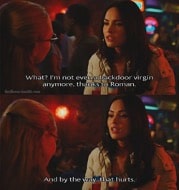In recent years, American films have dispelled and promoted exploitative and anti-feminist stereotypes, which oscillate between oversexualizing and victimizing the female identity. As a matter of fact, it is not uncommon for people to consider these stereotypes as simply a “performance” of the piece, or as a film created primarily to satisfy the viewing pleasure of its audience. But what happens, however, when the show becomes overly saturated with female representation that falls flat? This analysis will include the presentation of memes as a means of contextualizing how female representation is perceived in Hollywood cinema and how Hollywood cinema has continuously created a false stereotypical conception of women.
Jennifer’s Body (2009), a popularized “chick-horror film” which gained fame through actress Megan Fox’s performance, can be seen as an example of what Linda Williams describes in her analytical essay, Film Bodies: Gender, Genre, and Excess, as a film that “hinges on the spectacle of a sexually saturated female body”, a spectacle most “feminist critics would agree is feminine victimization” (706). The main character in the film never fails to show off her sexuality either; whether it is through a barely-there wardrobe or a line (see right) that illustrates the character’s sexual behaviors during a serious conversation, the film emphasizes her role as the satanic female who kills, has sex with, and demonstrates an overtly sexual image through her exposition of power. Despite the fact that it is refreshing to come across a horror film that reverses the roles of power, shouldn’t they have accomplished this without over-utilizing the body of the female character? Sure, they could have done it, but would it have achieved as much success by male viewers? Or Hollywood audiences in general?
The more recent argument discussed in Williams’s thesis and advanced by Carol J. Clover, suggests that “while feminists often pointed to the woman victims…more recent feminist work has suggested that the horror film [genre] may present an interesting and instructive case of sadistic roles for the pleasures of the masculine-identified viewer,” she goes further on to state that these viewers “oscillate between identifying with the passive powerlessness of the terrorized girl-victim and her later active empowerment” (707). These views however hold no real power on behalf of female representation—they are “gender-confused” and appeal to its “presumed male spectators” by the roles they assume (Williams 708). By providing small displays of female victory such as this meme where the scene gathers these two female characters in a ‘sexuality liberating encounter’ amidst a terrifying and scared moment, Williams’s theory symbolically “castrates” and creates “ gender-confused monsters” creating a “sadomasochistic thrill”—not for the empowerment of female representation, but for, and you guessed it right, for male viewing pleasure (708).
Films that set us back in the modern age of cinema are films like Sucker Punch (2011), a film entirely directed by a crew of male writers with incorporated male fantasy, male point of view, and male desire. This psychological fantasy action film depicts a mental whore house which depicts its leading female protagonist in risqué-wear, ambiguous and not so ambiguous acts of sexual molestation and victimization. In the end, the protagonist gives her life to facilitate the escape of one of her comrades, probably by allowing herself to be raped and killed; nevertheless, the film does not demonstrate this to the audience explicitly. The film touches upon old Hollywood roles common in the 1930s—the helpless victims drawn from the “virgin-whore dichotomy” (Benshoff & Griffin 228). As fascinating as the action sequences are, they drag on for too long as shots are taken from angles that reveal the cast’s inner thighs as they battle against the cold weather in short mini-skirts in what appears to be one of the coldest winters in all of northern China. Would you consider this to be a realistic or improved representation of women? I think not.
A film that straddles a totally different genre, Spy (2015), starring Melissa McCarthy, Jude Law, and Jason Statham, delivered a humorous narrative with our female protagonist at the forefront of the film’s storyline. Although our film includes non-traditional roles for our leading female character, it is important to recognize that conventional Hollywood narratives do not frequently present such roles, and when they do, the perspectives are primarily based upon male ambition. But let’s examine this particular film in more detail. Our protagonist is first depicted in the typical female role of an office assistant supporting her male counter-part Bradley, played by Jude Law. It is a relatively straightforward representation of a traditional female role, one in which women occupy a subordinate role or are less powerful figure in order to support other male leading archetypes. As spectators, we digest the same traditional roles in a disguised context; Hollywood is very adept at doing this. But, with an ass kicking, quick-witted female protagonist with her ability to outsmart her predators, the film attempts to overthrow hegemonic roles– but not entirely. Despite this, we can still appreciate our leading actress’s contributions to modern roles due to the fact that these roles didn’t even exist in early to mid-century cinema; in fact, women had a limited presence there. According to Harry M. Benshoff and Sean Griffin’s study, Women in Classical Hollywood Filmmaking, their analysis focuses on the ideological images of female representations, which perpetuated the early cinema’s perception that women’s metropolitan independence might leave them open to kidnapping and forced prostitution (220). In spite of times changing and women being able to watch a variety of female leads breaking the normative stereotypes, it has only been recently that we have been able to inject positive representation without that negative repercussion.
Female representation in early cinema, particularly in the 1930s, frequently was suppressed even behind the scenes because of the ongoing battle against the early misconceptions of the feminist wave. However, some Hollywood actresses were able to plant the seeds that paved the path for female representation in films today; “Katherine Hepburn often battled studio bosses over roles she felt were demeaning; Greta Garbo had input in choosing her own dialogue; and Mae West was best known for her gutsy onscreen persona (Benshoff & Griffin 227). Several on-screen personas and behind-the-scenes presences are leading the way towards a more positive representation of women in Hollywood films today. In the independent film Skate Kitchen (2018), an entirely female cast and director tell a women’s story from an uncommon point of view that shatters stereotypes of females and offers an alternative perspective on power, while simultaneously embracing queers, homosexuality, and sexual liberation in an inclusive, non-condescending manner. As a result of the inclusion of a female director and its underwriting by an additional female and the input of the cast to choose their own wardrobe, the film provides an organic insight into the lives of a group of women participating in a largely male-dominated activity such as skateboarding (Vanity Fair).
In summary, the explicit perversions of female representation are very much alive in today’s most modern cinema era, and the relationships between the spectator and the artform are still in a state of flux in the interests of improving the conditions that qualify for female representation. To help end on an issue I find intrusive in my viewing pleasures, I will do it with a quote from Linda Williams, “Obviously there is a great deal of work to be done to understand the form and function of the relation to the fundamental appeal as “original fantasies” between gender, genre, and structures (714).
Works Cited
Benshoff, Harry M., and Sean Griffin. America on Film: Representing Race, Class, Gender, and Sexuality at the Movies. John Wiley & Sons, Inc., 2021.
Han, Karen. “Skate Kitchen Proves There’s Strength in Numbers.” Vanity Fair, Vanity Fair, 16 Aug. 2018, https://www.vanityfair.com/hollywood/2018/08/skate-kitchen-collective-skateboarding-crystal-moselle-rachelle-vinberg-exclusive-clip.
Williams, Linda. “Film Bodies: Gender, Genre, and Excess.” Film Quarterly, vol. 44, no. 4, 1991, pp. 701–715.






